| |
|

Tuesday, May 27-Thursday, May 29 Lipinsky Family S.D. Jewish Arts Festival

Wednesday, May 28 JFS~Ellen Saks lecture on mental illness


Tuesday, June 3 Guardians Golf & Tennis Tournament


Thursday, June 5 Tifereth Israel's 'Girls Night Out'


Friday-Saturday, June 6-7 JFS~Judaism on the Wild Side


Sunday, June 8 Temple Solel~Tikkun Leil Shavuot




THE VIEW FROM JINSA
Syria-Israel peace discussions strain their respective alliances with Iran, United States
By Shoshana Bryen
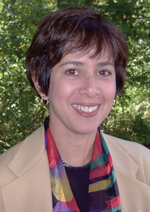 WASHINGTON, D.C.—Everyone has priorities; Bashar Assad received his from his father. First, keep the regime in power; second, maintain control of Lebanon; third, get the Golan Heights back. Close ties between Syria and Iran are essential to the first two priorities and those are working really, really well for Junior right now. WASHINGTON, D.C.—Everyone has priorities; Bashar Assad received his from his father. First, keep the regime in power; second, maintain control of Lebanon; third, get the Golan Heights back. Close ties between Syria and Iran are essential to the first two priorities and those are working really, really well for Junior right now.
Syria gets money, weapons and political cover from Iran in a complicated arrangement that includes having Iran's Shiite clerics accept Alawites (Assad's minority group) as true Muslims, not the deviant splinter they are sometimes claimed by others to be. Syria's role in Lebanon is enhanced by Iran's support for Hezbollah and by the money and weapons that flow to Lebanon from Iran via Damascus. On the other side of the country, Syria harbors terrorist forces that train and enter Iraq with impunity, helping Iran in its quest for hegemony there.
 United States policy has been to figure out how to "strip" Syria away from Persian Iran and restore it to the Arab world. Our goal is to reduce Iran's influence in Lebanon and Iraq, and dampen support for Palestinian and other terrorist groups emanating from Syria. We have cajoled, threatened and offered to bribe. The United States and Israel (and Saudi Arabia) were of one mind over Israel's raid on the Syrian/North Korean reactor last summer. United States policy has been to figure out how to "strip" Syria away from Persian Iran and restore it to the Arab world. Our goal is to reduce Iran's influence in Lebanon and Iraq, and dampen support for Palestinian and other terrorist groups emanating from Syria. We have cajoled, threatened and offered to bribe. The United States and Israel (and Saudi Arabia) were of one mind over Israel's raid on the Syrian/North Korean reactor last summer.
Syria not only refuses to be stripped, however, but sees itself on the winning side. In Lebanon, Hezbollah has learned from Hamas and has declined to take over the country. It doesn't want to be responsible for jobs and municipal services, preferring to leave that mess to Siniora. It has instead appropriated veto power over government, allowing it to remain an armed state-within-a state. Score one for the bad guys.
Second and very worrisome, Syria is busily engaged in "ally stripping" of its own - seeking to separate Israel from the United States and apparently finding willing listeners in Israel.
Syria claims it is willing to make "peace" with Israel in exchange for the Golan Heights. But if the Golan is only Syria's third priority (and it is), why now? The only way to make life better for Syria would be to engage the United States as a "partner" in "peace talks." If we engage them, we won't threaten them. If we don't engage, Israel will have to decide whether to pursue a separate peace with Syria or stick with the United States in worrying about the larger Syria-Iran-Hezbollah-Hamas axis and American security interests in Iraq. Ally stripping.
Recent headlines make the point. Ha'aretz - "Analysts: Syria-Israel Peace Deal Requires Shift in U.S. Policy." State Department brief - "Rice on Syria-Israel Talks: Peace Must Include End to Support for Terror." AP - "U.S. Cool on Israel-Syria." To be sure, there is also "Israel Sets Demands in New Syrian Peace Track: Break with Iran, Hezbollah and Hamas," on the Reuters/Washington Post story.
Which is more likely - that Syria will give up a successful and remunerative relationship with terrorism and Iran, or that the government of Israel will ask the United States to "help" Israel and Syria find "peace," sucking us into a "process" that does not serve the long term, broader interests of the United States, Israel or the region?



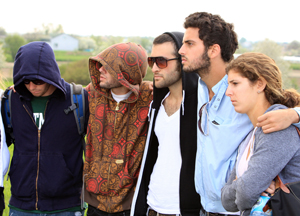 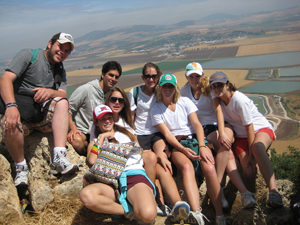
FROM THE GATES OF THE NEGEV
SDJA students visit Poland and Israel
By Ulla Hadar
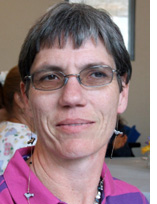 KIBBUTZ RUHAMA, Israel— A group of 46 graduating seniors of San Diego Jewish Academy have for the last three weeks been on a journey travelling through Poland and Israel. KIBBUTZ RUHAMA, Israel— A group of 46 graduating seniors of San Diego Jewish Academy have for the last three weeks been on a journey travelling through Poland and Israel.
The students left San Diego April 28, traveling first to Poland to enhance their classroom Holocaust studies. The group did its own version of the March of Living, visiting the Nazi-run death camps of Auschwitz, Birkenau and Majdanek. Jill Quigley, who heads SDJA's Judaic Studies program, accompanied the students for a portion of their journey.
Upon the group's arrival May 6 in Israel, a boarding school in Hod Hasharon served as the base for the group. From there they experienced several
field trips around the country, including visits to Jerusalem and Tel Aviv.
The San Diego Jewish Academy and the Sha'ar Hanegev High School have been exchanging students for the last 10 years. The exchange program play an important role in the education of the teenagers, to help them comprehend each community's way of life.
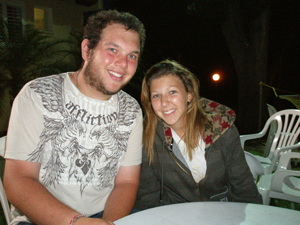 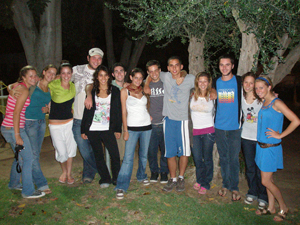
The teenagers arrived in the Sha'ar Hanegev municipality on Wednesday, May 21, and were accommodated in Kibbutz Dorot's guest house. Because of security problems in our region bordering Gaza, the activities allowed in the area were restricted. Nevertheless, there was a bonfire at the beach for Lag B'Omer and gatherings with the Sha'ar Hanegev students at several occasions.
In nearby Kibbutz Dorot, I met up with two amiable students: Sam Ulrich,18 and Tammy Sachs,18 to learn and hear about some of their feelings and experiences from this trip.
"The experience that made the most impact on me was when I saw the huge pile of shoes at the Majdanek camp in Poland," Ulrich said. "Some of the shoes still have colors on them and you feel people just stepped out of them... It is shocking to know that the camp is situated only 10 minutes away from the town!"... It annoyed me to see that people today use the area as a recreational oark and walk through it on their way to work, passing as nothing had happened there".
"In Birkenau camp I saw the tracks of the train leading into the camp and it changed my feelings about trains" Sachs mused. " For me a train always symbolized a trip or a way or means to arrive to another
place. Suddenly I realized that for millions of people the train started their last trip in life, a journey that ended with their death. From now on every time I will see train tracks this thought will go through my mind, and a train will not just be a train for travelling".
Sachs continued:"In Israel the most touching moment for me was when we visited the Kotel in Jerusalem.
The girls were all standing on the women's side just looking one at each other. Suddenly we all started to sing and dance together. Although this was a very emotional and joyous moment— being in Israel a Jew together with so many other Jews— in my mind I thought of all the millions that didn’t get a chance to come to Israel and experience the homeland of the Jews."
Both students said that they had no anxiety before their arrival in Israel. They said they didn't find the teenagers in the border communities of Sha'ar Hanegev very affected by the constant rocket attacks from Gaza. Although Sachs said she noticed some anxiety among the students from Sha'ar Hanegev when they visited Hod Hasharon and heard the news that another rocket had fallen in the Sha'ar Hanegev area. "Suddenly everyone was on their cell phones calling family and friends to see if they were all OK, this was the first time I noticed that the teenagers sustain anxiety."
Ulrich shared his plan for the future with me. He is going to study to be a rabbi. Next year he will start with a half year in New York and afterwards his plan is to continue his studying in Jerusalem.
From Sha'ar Hanegev the group continued to Eilat and is scheduled to return to San Diego in early June.
Larry Acheatel, executive director of San Diego Jewish Academy, recently visited Sha'ar Hanegev and also participated in an education conference in Jerusalem. He commented that SDJA and Sha'ar Hanegev
"have been exchanging teachers, students, administrators for the past ten years in one form or another.
"
As a result, our students, parents and teachers have formed deep connections and friendships with counterparts in Sha'ar Hanegev. These relationships are important and fulfilling on a personal level, but also serve to strengthen and deepen the connection between our two communities. We have both learned from the other."
The SDJA administrator added that during his most recent visit to Sha'ar Hanegev, "I was incredibly moved by the tenacity, strength and deep commitment of the residents of the region. While many families may not have the economic wherewithal to leave the region, most were committed to staying for very positive reasons. I admire the families who are committed to the land and their homes and not retreating even in the face of daily stress, rocket fire, and unnerving instability."
Acheatel described it as an "honor" to be with Sha'ar Hanegev residents, even if only for a very short while. He said it engendered an "even greater commitment to try and help build a new safe high school that will serve to let everyone (Israelis and Palestinians alike) know that the Sha'ar Hanegev community is strong and, in fact, will build for the future."

REFLECTIONS
Loving photography in the service of dance
San Francisco Ballet at Seventy-five by Janice Ross; Chronicle Books LLC, 2007; San Francisco, California; ISBN 100811856984; 188 Pages, including appendices on Company Repertoire (Title, Choreographer, Composer, Premiere dates), Artists past and present, Orchestra, Staff, Benefactors and other supporters, and Index, plus DVD $60.00
By Sheila Orysiek
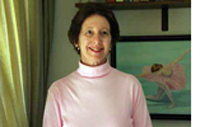 SAN DIEGO—
The most striking feature of this handsome coffee table sized celebratory publication is the pictures; beautiful, simply beautiful. And, beautiful because they are simple. In telling the story of a visual art such as dance, when photographs are included, they are a make or break component. All too often in publications such as this, an effort is made to “enhance” what the camera sees with what the photographer thinks it should see. In this instance no effort was made to distort or change what occurred; no multiple shots, no stroboscopic effect, no fading of the edges, no fractured views, no interference between the camera’s eye and that of the observer. The colors are brilliant, the composition and framing fortuitous; these photographs allow the dancers to communicate instead of attempting to artificially filter their message. Dance is a visual art and doesn’t need an artificial assist from the camera - just an honest report. SAN DIEGO—
The most striking feature of this handsome coffee table sized celebratory publication is the pictures; beautiful, simply beautiful. And, beautiful because they are simple. In telling the story of a visual art such as dance, when photographs are included, they are a make or break component. All too often in publications such as this, an effort is made to “enhance” what the camera sees with what the photographer thinks it should see. In this instance no effort was made to distort or change what occurred; no multiple shots, no stroboscopic effect, no fading of the edges, no fractured views, no interference between the camera’s eye and that of the observer. The colors are brilliant, the composition and framing fortuitous; these photographs allow the dancers to communicate instead of attempting to artificially filter their message. Dance is a visual art and doesn’t need an artificial assist from the camera - just an honest report.
 In addition to the line and curve symmetry of the pictures, we also get to see the details; how the ribbons are tied, the focus of the eyes, incidentals of costuming, a shine of perspiration, the intensity of muscle and tendon - but never for its own sake. These are not pseudo-artsy pictures for the embellishment of the photographer’s ego. Rather these photographs are at the service of the dance, taken with an appreciative knowing eye - and because of that honesty, the photographer is as much an artist as the subject. In addition to the line and curve symmetry of the pictures, we also get to see the details; how the ribbons are tied, the focus of the eyes, incidentals of costuming, a shine of perspiration, the intensity of muscle and tendon - but never for its own sake. These are not pseudo-artsy pictures for the embellishment of the photographer’s ego. Rather these photographs are at the service of the dance, taken with an appreciative knowing eye - and because of that honesty, the photographer is as much an artist as the subject.
Each photograph is scrupulously identified with the names of the dancers, the year, as well as the ballets in which they are pictured. This, too, is an important record all too often carelessly overlooked. For the dance lover few things are as frustrating as seeing a wonderful picture with no identification. It is obvious that each photo was carefully - even lovingly - chosen.
Janice Ross, who is a member of the Jewish community, states in her introduciton that her goal is to afford the reader a dual experience; the “inside” and “outside” worlds of the San Francisco Ballet. She notes that while the rarely seen “inside” view is engrossing, it is ultimately a process not a product. The product, the finished work, can only be realized from the “outside” - as a member of the audience. Dance has to be seen from the front.
San Francisco Ballet is America’s oldest professional company. From its birthday on June 2, 1933 to the date of publication (2007), Ross takes us through the various stages in the birthing process as well as the previous history which led to that birth. Gaetano Merola, general director of the San Francisco Opera, wanted a first class opera company for his brand new first class opera house and for that he needed a strong ballet company. He was wise enough to know that a truly strong ballet group would need not only to perform as part of the opera but also independently; seeking its own artistic voice.
Ross presents the story - past and present - of the Company and happily includes all of its attendant parts. This is done in both broad strokes as well as loving detail; the reader can enjoy both. It is this combined presentation - broad and detailed - which enables the book to appeal to the balletomane and/or the more casual observer. It is also instructive to some, or a reminder to others, of the enormous effort and the variety of expertise it takes to put a few minutes of dance on stage.
I applaud Ross’s decision to include all the many supportive components that enable dancers to dance in a Company experience. She gave importance to artistic direction, pedagogy, choreographers, orchestra, administrative staff, the various boards and supporting benefactors, fund raising, volunteers, backstage support staff, ballet school, work spaces, performing venues, budgetary concerns, physical therapists/medical staff and more - she left no one out. This gives the reader a much more rounded sense of what it takes to present dance - a fuller view of the life of a dance company.
San Francisco Ballet has been a trailblazer in many areas that we now take for granted, such as the first company in the United States to present a full length Nutcracker and make it the annual Christmas treat it has become. The reader is given the opportunity to follow thought by thought and move by move as a renowned choreographer such as William Forsythe works with the dancers. But also engaging is the mundane but interesting detail that the Company travels with its own clothes washer and dryer - which brings a smile to the face of anyone who has ventured abroad.
Though the one hour forty minute DVD which accompanies the book covers much of the same ground as the book, it is not repetitive since it moves the story into another dimension. We get to hear the voices of the people like the Christensen brothers, some of the original dancers and many others who traveled the road with the Company in the past and those who are part of it now. From film clips of early performances, class work and rehearsals to the present day - we get to see how the dancers moved then and how they move now. This DVD adds substantially as a visual adjunct; well paced, well presented. Of course, one wishes each dance piece could have been longer; but covering seventy five years of dance and Company history is already a task. It does whet the appetite.
The information in the book is easily accessed through sensible chapter division, the Appendices and the Index. I had only one quibble - the font used for the main body of the text is quite small and a tad pale which made reading difficult. It was the only flaw - and a subjective one at that. Obviously, this entire production comes from a knowing hand, a selective eye and fueled by a labor of love; a testimony to a Company which has performed to acclaim on major stages around the world. I do heartily recommend it.
About the Author: Janice Ross, an associate professor of dance history in the drama department at Stanford University, was staff dance critic for the Oakland Tribune and San Francisco correspondent for Dance Magazine for 20 years. She is the author of Moving Lessons: Margaret H’Doubler and the Beginning of Dance in American Education and Anna Halprin: Experience as Dance (for which she received a Guggenheim Fellowship), and her essays on dance have appeared in numerous publications. A past president of the Dance Critics Association, she is currently president-elect of the Society of Dance History Scholars. She lives in Atherton, California.
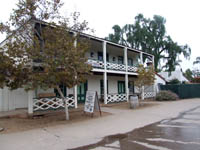
Robinson-Rose House
|
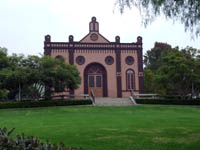
Old Temple Beth Israel |
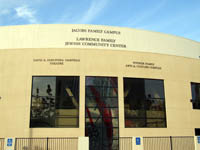
Lawrence Family JCC |
Editor's Note: We are reprinting news articles that appeared in back issues of various San Diego Jewish newspapers. You may access an index of the headlines of those articles by clicking here. You may also use the Google search program on our home page or on the headline index page to search for keywords or names.
Estate of Sam Fox Bequeathed to Relatives
From Southwestern Jewish Review, July 6, 1939, page 1
Jonathan H. Fox and Lillian M. Gaynes, children of Samuel I. Fox, Jewish civic leader who died June 24, were bequeathed most of the fox estate, according to a will filed with the county clerk.
The son and daughter and a son-in-law, Arthur F. Gaynes, were named executors of the estate valued at “over $10,000.” The will, entirely in Mr. Fox’s handwriting, was drawn on April 5 1937.
Specific bequests were $500 each to his son’s wife, Leslie Fox; his son-in-law, Mr. Gaynes, and a sister, Lena Birnbaum; and 200 each to his nieces, Esther Cziun, Lilly Szues, Blanch Lux, Rose Straub, Lilly Seligman, Betty Frank; two nephews, Geo Mandel and Jancho Mandel; two grandchildren, Evelyn and Beatrice Gaynes, and a sister-in-law, Sophie C. Kuhn. The remainder of the estate was left to Mrs. Gaynes and Jonathan Fox, to be divided equally.
Lasker Lodge Installation Due Sunday
From Southwestern Jewish Review, July 6, 1939, page
Originally scheduled for June 25, the Lasker Lodge installation of officers will be held Sunday, July 9, at 8 p.m. in the Plata Real, U.S. Grant Hotel. The event was postponed because of the death the previous day of Samuel I. Fox.
The affair will be the lodge’s 53rd annual installation. Morey Levenson will succeed A.L. Solof as president of the organization.
Noted out-of-town visitors are expected to attend. After a short and interesting intstallation ceremony, dancing will follow. Although admission is free, bids must be obtained from Secretary Jack Rosenblum of Lasker Lodge, or Abe Dubin, chairman of the installation.
The public is cordially invited and a special invitation is issued to members of the Birdie Stodel Auxiliary, the Junior B.B. Girls, and the A.Z.A.
Famed Jurist to Visit S.D.
From San Diego Jewish Press, April 24, 1940, page 1
Dr. Manfred Arie, noted Viennese jurist and profound student of Jewish problems, will speak at El Cortez Hotel on May 5th in behalf of the United Jewish Appeal for Refugees and Overseas needs.
The United Jewish Appeal for Refugees and Overseas Needs, representing the combined efforts of the Joint Distribution Committee, the United Palestine Appeal and the National Refugee Service is devoted to the three-fold task of relief and reconstruction in Europe, immigration and resettlement in Palestine and refugee adjustment in the United States>
Dr. Arie, who is now living in Williamsport, Pa., was “Oberlandesgerichsrat und Senatsvorsitzender” in Vienna, a position equivalent to thatof a State Supreme Court judge in the United States. He was a member of the Jewish Academic Fraternity “Hasmonaca” and a member of the Ring der Alten Herrn Juedischer Verbindungen” in Vienna.
A doctor of law, and a professor of criminal law, Dr. Arie contributed numerous articles on legal questions and Jewish problems to Continental publications, and before coming to this country was active as a leading interpreter of the law in Austria.
During the war, Dr. Arie served as a judge with the rank of captain and received four medals for distinguished service. Following the war he was named district attorney in Vienna, the only Jew who ever held that post.
With a keen insight into the problems of Jewry throughout the world, Dr. Arie has long studied the situation of the Jews in European lands and several years ago traveled to Palestine, better to acquaint himself with the position of the Jews there.
{Return to top}

Nancy Harrison
cruise & tour specialist
(619) 265-0808

SAN DIEGO JEWISH WORLD THE WEEK IN REVIEW
Ulla Hadar in Kibbutz Ruhama, Israel: Blammmm! A Kassam in my back garden?
Donald H. Harrison in San Diego: JACC theme: 'Keeping Israel on the map'
Rabbi Baruch Lederman in San Diego: Slain Torah scholar started as dishwasher
Rabbi Leonard Rosenthal in San Diego: 'Sanctified shekel' hints at money's purpose
Isaac Yetiv in La Jolla, California: 'If the shoe fits' ... Obama and appeasement
Adventures in San Diego Jewish History: What was the Jewish community news in 1922 or 1939? Who were the newsmakers? Our archives answer these questions in daily installments
Carol Davis in Ottawa, Canada: A Jewish rendezvous in Canada
Ulla Hadar in Kibbutz Ruhama, Israel: Israeli mayors neighboring Gaza demand Israel's goverment stop the terrorist rockets
Sheila Orysiek in San Diego: Chapter Nine in the serialization of her novel, Reluctant Martyr
Ira Sharkansky in Jerusalem: Are peace talks Olmert's diversion?
Howard Wayne in San Diego: Farewell to two dear friends: Lionel Van Deerlin and Mike Gotch
Adventures in San Diego Jewish History: What was the Jewish community news in 1950? Who were the newsmakers? Our archives answer these questions in daily installments
Donald H. Harrison in San Diego: Reelect San Diego Mayor Jerry Sanders
Eran Lerman in Jerusalem: 'Peres' Planet': Electric cars, Arab-Israeli cooperation, new cities in the Arava
Hal Wingard in San Diego: His songs "Adira Hee," "Lech L'cha," and "Mitzvah Soup"
Adventures in San Diego Jewish History: What was the Jewish community news in 1950? Who were the newsmakers? Our archives answer these questions in daily installments
Donald H. Harrison in San Diego: Protecting America's 'House of Pluralism'
Evelyn Kooperman in San Diego: San Diego Jewish Trivia: Balboa Park
Adventures in San Diego Jewish History: What was the Jewish community news in 1950? Who were the newsmakers? Our archives answer these questions in daily installments
Shoshana Bryen in Washington, D.C—President Bush in Mideast made us kvell
Donald H. Harrison in San Diego: Marti, Marty: Candidates giving us nachas
J. Zel Lurie in Delray Beach, Florida: What we imagine the Bush and Olmert families 'really' said to each other
Dorothea Shefer-Vanson in Mevasseret Zion, Israel: From would-be English grl to Zionist
Eileen Wingard in San Diego: 'Blue' songs detract from Jewish anthology
Adventures in San Diego Jewish History: What was the Jewish community news in 1950? Who were the newsmakers? Our archives answer these questions in daily installments
Link to previous editions
< BACK TO TOP
|
|
